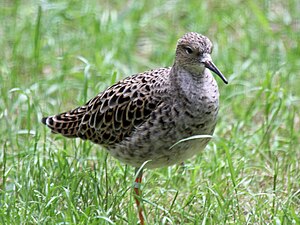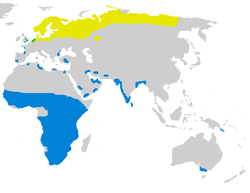ബഹുവർണ്ണൻ മണലൂതി
ബഹുവർണ്ണൻ മണലൂതിയ്ക്ക് ആംഗലത്തിൽ ruff എന്നു പേര്. ശാസ്ത്രീയ നാമംPhilomachus pugnax' എന്നാണ്. ദേശാടനം നടത്തുന്ന പക്ഷിയാണ്.
| ബഹുവർണ്ണൻ മണലൂതി | |
|---|---|

| |
| പൂവന്മാർ,നെതർലന്റിൽപ്രജനനസയത്ത് | |

| |
| പിട, പ്രജനന സമയത്ത് | |
| ശാസ്ത്രീയ വർഗ്ഗീകരണം | |
| കിങ്ഡം: | |
| Phylum: | |
| Class: | |
| Order: | |
| Family: | |
| Genus: | Philomachus Merrem, 1804
|
| Species: | P. pugnax
|
| Binomial name | |
| Philomachus pugnax (Linnaeus, 1758)
| |

| |
Breeding summer visitor Present all year Non-breeding range | |
| Synonyms | |
|
Calidris pugnax | |
വിതരണം
തിരുത്തുകതണുപ്പുകാലത്ത് ഇവ തെക്കും പടിഞ്ഞാറും യൂറോപ്പ്, ദക്ഷിണ ഏഷ്യ, ,ആസ്ത്രേലിയ എന്നിവിടങ്ങളിൽ കൂട്ടം കൂടും.
പ്രജനനം
തിരുത്തുകവടക്കൻ യൂറേഷ്യയിൽ ചതുപ്പുകളിലും വെള്ളമുള്ള പുൽമേടുകളിലും പ്രജനനം നടത്തുന്നു. ഇവ കൊല്ലത്തിൽ ഒരു കാലത്തു മാത്രമെ മുട്ടയിടുകയുള്ളു. നിലത്ത് പെട്ട്വെന്നു തിരിച്ചറിയാനാവാത്ത കൂട് ഉണ്ടാക്കുന്നു. തനിയെ വിരിയുന്ന കുഞ്ഞുങ്ങൾ വിരിഞ്ഞ ഉടനെ നടക്കാൻ തുടങ്ങുന്നു. കുറുക്കൻ മുതലായവയും വലിയ പക്ഷികളും കുഞ്ഞുങ്ങളെ ഭക്ഷിക്കും..
ഭക്ഷണം
തിരുത്തുകനനഞ്ഞപുൽമേടുകളിൽ പ്രധാനമായും ഇര തേടുന്നു. പ്രാണികളേയും ധാന്യങ്ങളും ഭക്ഷണമാക്കുന്നു.
രൂപ വിവരണം
തിരുത്തുകമറ്റു മണലൂതികളെപ്പോലെ വീതിയുള്ള കൊക്കും കൂർത്ത വാലും ഉണ്ട്. ഇവയ്ക്ക് നീണ്ട കൊക്ക്, വലിയ വയർ. പൂവനും പിടയ്ക്കും വെവ്വേറെ രൂപം. പ്രജനന സമയത്ത് തൂവലുകളിൽ നിറം മാറും. പിടയ്ക്കും പൂവന്പ്രജനന സമയമല്ലാത്തപ്പോഴും(കേരളത്തിൽ കാണുന്ന സമയത്ത്)ചാര- തവിട്ടു നിറത്തിലുള്ള അടിവശം, അധികം വെള്ള നിറവുമാണ് തിരിച്ചറിയാനാവുന്ന തരത്തിലുള്ള വയർ, ചെറിയ തല, ഇടത്തരമ്നീളമുള കഴുത്ത് , നീണ്ടകാലുകൾ, കാലുകൾ മഞ്ഞയൊ ഓറഞ്ചു നിറമൊപറക്കുമ്പോൾ തിരിച്ചറിയാവുന്ന ചിറകിൽ വീതികുറഞ്ഞ വെള്ള വര. [4] പൂവനേയും പിടയേയും തിരിച്ചറിയാനാവും [5]പൂവൻ പിടയേക്കാൾ വലുതാണ്. 29-32 സെ.മീനീളം, 54-60 സെ.മീ ചിറകു വിരിപ്പ്. [4] 108 ഗ്രാം തൂക്കം.[6] പ്രജനന കാലത്ത് കൊക്ക്, കാൽ, മുഖത്തെ തൂവലില്ലാത്ത ഭാഗത്തെ ത്വക്ക് ഇവ ഓറഞ്ചുനിറമായിരിക്കും.[4]ചാര തവിട്ടു നിറത്തിലുള്ള പുറകിനു കറുപ്പോ ചെമ്പൻ നിറത്തിൽ ചെതുമ്പൽ പോളുള്ള അടയാളം. അടിയിൽ വെള്ള നിറം. നെഞ്ചിൽ കറുപ്പ്. [7][8]
പ്രജനന സമയത്തല്ലാത്തപ്പോൾ മുകൾവശം ചാര- തവിട്ടു നിറം. അടിവശംവെള്ള. നെഞ്ച്ുംവശങ്ങളും യിൽ ചാര അടയാളങ്ങൾ.[4]
ഇവയ്ക്ക് തൂവൽ പൊഴിക്കുന്ന സ്വഭാവമുണ്ട്. ദേശാടന പറക്കലിന് കൂടുതൽ ഊർജ്ജം ലാഭികാക്കാനായിരിക്കും ഇത് .[9]
രൂപ വിവരണം
തിരുത്തുകപൂവന് 31-34 സെ.മീ ഉം 24-26 സെ.മീ. പിടയ്ക്കും നീളമുണ്ട്. നീലമുള്ള കാലുകൾ, ചെറിയ തല, ഇടത്തരം വലിപ്പമുള്ള കൊക്കുകൾ എന്നിവയുണ്ട്. പൂവന് പിടയേക്കാൾ വലിപ്പമുണ്ട്. ചിറകു വിരിപ്പ് പൂവൻ` 52 -60 സെ.മീ.ഉം പിടയ്ക്ക് 46- 50 സെ.മീ. ഉം ആണ്.
വിതരണം
തിരുത്തുകഇതൊരുദേശാടന പക്ഷിയാണ്. വടക്കൻ യൂറേഷ്യയുടെ ഈർപ്പമുള്ള പ്രദേശങ്ങളിൽ പ്രജനനം നടത്തുന്നു. തണുപ്പുകാലത്ത് ഉഷ്ണ മേഖലയിലേക്ക് ദേശാടനം നടത്തുന്നു കൂടുതലായി ആഫ്രിക്കയിലേക്കും. ഈഏർപ്പമില്ലാത്ത അധികം കുറ്റിക്കാടുകളില്ലാത്ത സ്ഥലങ്ങളിൽ കൂടു വെക്കുന്നു..[12] അധികം മേച്ചിൽ നടത്താത്ത സ്ഥലങ്ങളാണ് കൂടുവെക്കാൻ തെരെഞ്ഞെടുക്കുന്നതെന്ന് ഹംഗറി യിൽ നടത്തിയ ഒരു പഠനം തെളിയിക്കുന്നു. [13]പ്രജനന സമയമല്ലാത്തപ്പോൾ ആഴം കുറഞ്ഞ ജലാശങ്ങളിലാണ് ഇര തേടുന്നത്. [12] ഇവയുടെ സാന്ദ്രത ച.കി.മീറ്ററിന് 129 എണ്ണമാണ്. പലപ്പോഴും ഇതിലും വളരെ കുറവായിരിക്കും. [14]
നൂറുകണക്കിനൊ ആയിരക്കണക്കിനൊ ഉള്ള കൂട്ടങ്ങളായി ദേശാടനം നടത്തുന്നു. [13]സെനഗലിൽ കണ്ട ഒരു കൂട്ടത്തിൽ പത്തു ലക്ഷം പക്ഷികൾ ഉണ്ടായിരുന്നു. [7] വളരെ ചെറിയൊരു കൂട്ടം ബർമ്മ, തെക്കൻചൈന എന്നിവിടങ്ങളിലേക്ക് ദേശാടനം നടത്തുന്നുണ്ട്. [7] ന്യൂഗിനിയ, ആസ്റ്റ്രേലിയ യുടെ ഭാഗങ്ങൾ എന്നിവിടങ്ങളിലും കാണുന്നു. </ref> [7] [15] [16] [17]
പ്രജനനം
തിരുത്തുകഇവ യൂറോപ്പിലും ഏഷ്യയിൽ [[സ്കാൻഡിനേവിയ]മുതലും ഗ്രേറ്റ് ബ്രിട്ടനിലുമ്പസിഫിക്ക് വരേയും പ്രജനനം നടത്തുന്നു..[18]
പൂവൻ കൂട് കെട്ടുന്നതിലൊ കുഞ്ഞുങ്ങളെ പോറ്റുന്നതിലൊ ശ്രദ്ധിക്കാറില്ല. 4 മുട്ടകളിടുന്നു. 21-24 ദിവസങ്ങല് കൊണ്ട് പിട അടയിരുന്ന്് മുട്ട വിരിയിക്കുന്നു. വിരിഞ്ഞ ഉടനെ ഇരതേടാൻ തുടങ്ങുന്നു. 23 ദിവസം കൊണ്ട് പറക്കാറാകുന്നു. [19] ജൂൺ അവസാനത്തിലൊ ജൂലയ് ആദ്യത്തിലൊ പൂവൻ പ്രജനന സ്ഥലം വിടുന്നു. ജൂലായ് അവസാനം പിടയും കുഞ്ഞുങ്ങളും. [20] പൂവന്മാർ കുറച്ച് ദൂരത്തേക്ക് ദേശാടനം നടത്തുമ്പോൾ പിടകൾ കൂടുതൽ ദൂരത്തേക്ക് പോകുന്നു. ബ്രിട്ടനിൽ പൂവന്മാരെ മാത്രം കാണുന്നു,[21] കെനിയയിൽ കാണുന്നത് അധികവും പിടകളാണ്.[22] പൂവന് വലിപ്പകൂടുതൽ ഉള്ള കാരണം പിടയെ അപേക്ഷിച്ച് തണുപ്പു സഹിക്കാനുള്ള കഴിവ് കൂടുതലുണ്ട്.[21]
ഇവദേശാടനം ഒരേ പാതയിലൂടെ തന്നെ നടത്തുന്നു. ഭക്ഷണത്തിനുള്ള ഇടത്താവളങ്ങളും ഒന്നു ത്ന്നെ തിരഞ്ഞെടുക്കുന്നു. വളയമിട്ടും നിറം കൊടുത്തും നടത്തിയ നിരീക്ഷണങ്ങളിൽ ഇത് തെളിഞ്ഞിട്ടുണ്ട്. [20] ഇവ ഇന്ധനത്തിനായി കൊഴുപ്പ് സൂക്ഷിക്കുന്നു.[23]
Vol. 1 (1770)
പ്രജനനം
തിരുത്തുക4 മുട്ടകൾ ഇടുന്നു.[7][12] മുട്ടകൾ ഇളം പച്ചയൊ ഒലീവ് നിറമൊ ആയിരിക്കും. ഇരുണ്ട അടയാളങ്ങളുമുണ്ട്.[12] പിടയാണ് അടയിരിക്കുന്നത്. 20-23 ദിവസത്തിനകം മുട്ട വിരിയുന്നു. 25-28 ദിവസത്തികം കുഞ്ഞുങ്ങൾ പറക്കുന്നു. .[6][24][25][26] [26][27]
[28][29][30]
ഭക്ഷണം
തിരുത്തുകപ്രജനന കാലത്ത് പ്രാണികളുടെ ലാഋവകളാണ് പ്രധാന ഭക്ഷണം.ദേശാടന കാലത്ത് പ്രാണികൾ, പുൽച്ചാടികൾ, എട്ടുകാലി, പുഴുക്കൾ, തവളകൾ, ചെറു മത്സ്യങ്ങൾ, വിത്തുകൾ, ധാന്യങ്ങൾ, പുല്ല്, ജല സസ്യങ്ങൾ എന്നിവ ഭക്ഷിക്കുന്നു.[13]
ഇടത്താവളങ്ങളിൽ ഭഷണം കഴിച്ചാണ് ഇവയുടെ ദേശാടനം. [31]
ധാന്യങ്ങളാണ് പ്രധാന ഭക്ഷണം. [32]
അവലംബം
തിരുത്തുക- ↑ "Philomachus pugnax". IUCN Red List of Threatened Species. Version 2013.2. International Union for Conservation of Nature. 2012. Retrieved 26 November 2013.
{{cite web}}: Cite has empty unknown parameter:|last-author-amp=(help); Invalid|ref=harv(help); Unknown parameter|authors=ignored (help) - ↑ Thomas, Gavin H.; Wills, Matthew A.; Székely, Tamás (2004). "A supertree approach to shorebird phylogeny". BMC Evolutionary Biology. 4 (28): 1–18. doi:10.1186/1471-2148-4-28. PMC 515296. PMID 15329156.
{{cite journal}}: CS1 maint: unflagged free DOI (link) Figure 7 shows relevant relationships. - ↑ Lockwood (1984) 127–128
- ↑ 4.0 4.1 4.2 4.3 Mullarney et al. (1999) 156
- ↑ Jukema, Joop; Piersma, Theunis (2000). "Contour feather moult of Ruffs Philomachus pugnax during northward migration, with notes on homology of nuptial plumages in scolopacid waders". Ibis. 142 (2): 289–296. doi:10.1111/j.1474-919X.2000.tb04868.x.
- ↑ 6.0 6.1 "Ruff Philomachus pugnax [Linnaeus, 1758]". Bird facts. British Trust for Ornithology. Retrieved 16 April 2009.
- ↑ 7.0 7.1 7.2 7.3 7.4 ഉദ്ധരിച്ചതിൽ പിഴവ്: അസാധുവായ
<ref>ടാഗ്;haymanഎന്ന പേരിലെ അവലംബങ്ങൾക്ക് എഴുത്തൊന്നും നൽകിയിട്ടില്ല. - ↑ Lank, David B.; Dale, James (2001). "Visual signals for individual identification: the silent "song" of Ruffs" (PDF). The Auk. 118 (3): 759–765. doi:10.1642/0004-8038(2001)118[0759:VSFIIT]2.0.CO;2.
- ↑ Karlionova, Natalia; Meissner, Wlodzimierz; Pinchuk, Pavel (2008). "Differential development of breeding plumage in adult and second-year male Ruffs Philomachus pugnax". Ardea. 96 (1): 39–45. doi:10.5253/078.096.0105.
{{cite journal}}: Cite has empty unknown parameter:|quotes=(help) - ↑ Britton, David (August 1980). "Identification of Sharp-tailed Sandpipers". British Birds. 73 (8): 333–345.
- ↑ Vinicombe, Keith (May 1983). "Identification pitfalls and assessment problems: 4. Buff-breasted Sandpiper Tryngites subruficollis". British Birds. 76 (5): 203–206.
- ↑ 12.0 12.1 12.2 12.3 Snow & Perrins (1998) 628–632
- ↑ 13.0 13.1 13.2 "Philomachus pugnax". Species factsheet. BirdLife International. Retrieved 16 April 2009.
- ↑ Blokhin, Y. Yu. (1998). "Spatial and temporal dynamics of wader numbers in the delta complexes of the northern subarctic" (PDF). International Wader Studies. 10: 214–220.
- ↑ Johnson, James A.; Lanctot, Richard B.; Andres, Brad A.; Bart, Jonathan R.; Brown, Stephen C.; Kendall, Steven J.; Payer, David C. (September 2007). "Distribution of breeding shorebirds on the Arctic coastal plain of Alaska" (PDF). Arctic. 60 (3): 277–293. Archived from the original (PDF) on 2022-08-10. Retrieved 2015-09-29.
- ↑ "Saryarka – steppe and lakes of northern Kazakhstan" (PDF). World heritage sites. United Nations Environment Programme and World Conservation Management Centre. Archived from the original (PDF) on 2010-08-02. Retrieved 30 June 2009.
- ↑ (in Russian) Khrokov, V. (1988). "Breeding record of Ruff Philomachus pugnax in Northern Kazakhstan". Ornitologiya. 23: 224–225.
- ↑ "Ruff Philomachus pugnax" (PDF). United Kingdom Special Protection Areas. Joint Nature Conservation Committee. Archived from the original (PDF) on 2011-02-04. Retrieved 2015-09-29. Retrieved 16 April 2009. Estimates for the Russian population vary widely, and I have used the minimum figure given in Snow & Perrins (1998) 628–632
- ↑ http://www.luontoportti.com/suomi/en/linnut/ruff
- ↑ 20.0 20.1 Baccetti, N.; Gambogi, R.; Magnani, A.; Piacentini, D.; Serra, L. (1998). "Stop-over strategy of Ruff Philomachus pugnax during the spring migration" (PDF). International Wader Studies. 10: 65–369.
- ↑ 21.0 21.1 Berthold et al. (2001) 51–52
- ↑ Pearson, D. J. (1981). "The wintering and moult of ruffs Philomachus pugnax in the Kenyan Rift Valley". Ibis. 123 (2): 158–182. doi:10.1111/j.1474-919X.1981.tb00922.x.
- ↑ Vaillancourt, Eric; Prud'Homme, Sophie; Haman, François; Guglielmo, Christopher G; Weber, Jean-Michel (2005). "Energetics of a long-distance migrant shorebird (Philomachus pugnax) during cold exposure and running" (PDF). Journal of Experimental Biology. 208 (Pt 2): 317–325. doi:10.1242/jeb.01397. PMID 15634851.
- ↑ "Management of wet grassland habitat to reduce the impact of predation on breeding waders: Phase 2". Science and research projects. Department for Environment, Food and Rural Affairs (DEFRA). Archived from the original on 2016-03-03. Retrieved 23 April 2009.
- ↑ Bolton, Mark; Tyler, Glen; Smith, Ken; Bamford, Roy (2007). "The impact of predator control on lapwing Vanellus vanellus breeding success on wet grassland nature reserves". Journal of Applied Ecology. 44 (3): 534–544. doi:10.1111/j.1365-2664.2007.01288.x.
- ↑ 26.0 26.1 van der Wal, R.; Palmer, Stephen C. (2008). "Is breeding of farmland wading birds depressed by a combination of predator abundance and grazing?" (PDF). Biology Letters. 4 (3): 256–258. doi:10.1098/rsbl.2008.0012. PMC 2610041. PMID 18381262.
- ↑ Achim, Johann. "EAZA Husbandry guidelines for the Ruff (Philomachus pugnax)" (PDF). European Association of Zoos and Aquaria (EAZA). Archived from the original (PDF) on 2004-05-10. Retrieved 23 April 2009.
- ↑ Threlfall, William; Wheeler, Terry A. (1986). "Ectoparasites from birds in Newfoundland" (PDF). Journal of Wildlife Diseases. 22 (2): 273–275. doi:10.7589/0090-3558-22.2.273. PMID 3712656.
- ↑ Mendes, Luisa; Piersma, Theunis; Lecoq, M.; Spaans, B.; Ricklefs, Robert E. (2005). "Disease-limited distributions? Contrasts in the prevalence of avian malaria in shorebird species using marine and freshwater habitats". Oikos. 109 (2): 396–404. doi:10.1111/j.0030-1299.2005.13509.x.
- ↑ Piersma, T. (1997). "Do global patterns of habitat use and migration strategies co-evolve with relative investments in immunocompetence due to spatial variation in parasite pressure?". Oikos. 80 (3): 623–631. doi:10.2307/3546640. JSTOR 3546640.
- ↑ Piersma, Theunis (1998). "Phenotypic flexibility during migration: optimization of organ size contingent on the risks and rewards of fueling and flight?". Journal of Avian Biology. 29 (4): 511–520. doi:10.2307/3677170. JSTOR 3677170.
- ↑ Trolliet, B.; Girard, O. (1991). "On the Ruff Philomachus pugnax wintering in the Senegal Delta" (PDF). Wader Study Group Bulletin. 62: 10–12.
- Berthold, Peter; Bauer, Hans-Günther; Westhead, Valerie (2001). Bird migration: a general survey. Oxford University Press. ISBN 0-19-850787-9.
- Boere, G.C.; Galbraith, C.A.; Stroud., D.A. (2006). Waterbirds around the world. Edinburgh: The Stationery Office. ISBN 0-11-497333-4.
- Cocker, Mark; Mabey, Richard (2005). Birds Britannica. Chatto & Windus. ISBN 0-7011-6907-9.
- Coward, Thomas Alfred (1930). The birds of the British Isles and their eggs. Volume 1 (4th ed.). Frederick Warne.
- del Hoyo, Josep; Elliott, Andrew; Sargatal, Jordi. (1996). Handbook of the Birds of the World: Hoatzin to Auks. Volume 3. Barcelona: Lynx Edicions. ISBN 84-87334-20-2.
- Hayman, Peter; Marchant, John; Prater, Tony (1986). Shorebirds: an identification guide to the waders of the world. Boston: Houghton Mifflin. ISBN 0-395-60237-8.
- Liddell, Henry George and Robert Scott (1980). A Greek-English Lexicon (Abridged edition). United Kingdom: Oxford University Press. ISBN 0-19-910207-4.
- Linnaeus, C (1758). Systema naturae per regna tria naturae, secundum classes, ordines, genera, species, cum characteribus, differentiis, synonymis, locis. Tomus I. Editio decima, reformata (PDF) (in Latin). Holmiae: Laurentii Salvii.
{{cite book}}: CS1 maint: unrecognized language (link) - Lockwood, W.B. (Editor) (1984). The Oxford Book of British Bird Names. Oxford: Oxford University Press. ISBN 0-19-214155-4.
{{cite book}}:|first=has generic name (help) - Merrem, Blasius (1804). Allgemeine literatur-zeitung (in German). Jena: Halle.
{{cite book}}: CS1 maint: unrecognized language (link) - Mullarney, Killian; Svensson, Lars; Zetterstrom, Dan; Grant, Peter (1999). Collins Bird Guide. Collins. ISBN 0-00-219728-6.
- Payne, Robert B. (1984). Sexual selection, lek and arena behavior, and sexual size dimorphism in birds (ornithological monographs: No. 33). Washington D. C.: American Ornithologists’ Union. ISBN 0-943610-40-0.
- Pennant, Thomas (1776). British Zoology. Volume 2: Water Birds (PDF). London: B. White.
- Simpson, D.P. (1979). Cassell's Latin Dictionary (5 ed.). London: Cassell Ltd. ISBN 0-304-52257-0.
- Slater, Peter (1970). A field guide to Australian birds: non-passerines. Adelaide: Rigby. ISBN 0-85179-102-6.
- Snow, David; Perrins, Christopher M. (editors) (1998). The Birds of the Western Palearctic concise edition (2 volumes). Oxford: Oxford University Press. ISBN 0-19-854099-X.
{{cite book}}:|author2=has generic name (help)
പുറത്തേക്കുള്ളകണ്ണികൾ
തിരുത്തുക- Ruff – Species text in The Atlas of Southern African Birds.
- Mating strategy introduction and research Archived 2007-10-31 at the Wayback Machine.
- Ruffs on postage stamps: www.birdtheme.org and www.bird-stamps.org
- Ageing and sexing (PDF; 2.0 MB) by Javier Blasco-Zumeta & Gerd-Michael Heinze Archived 2014-12-02 at the Wayback Machine.
